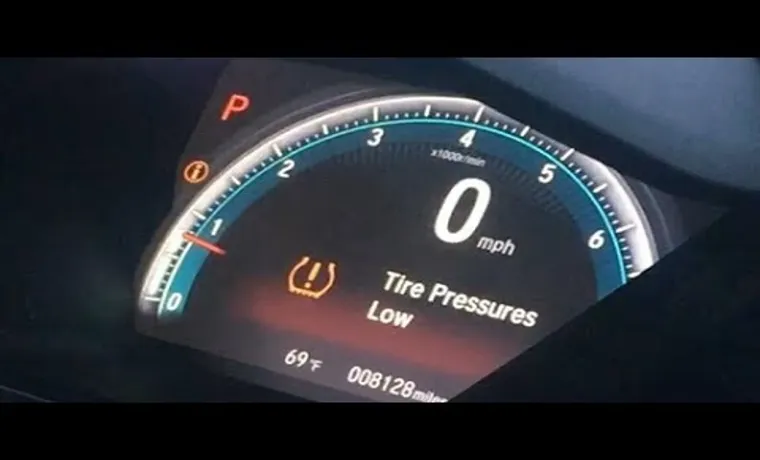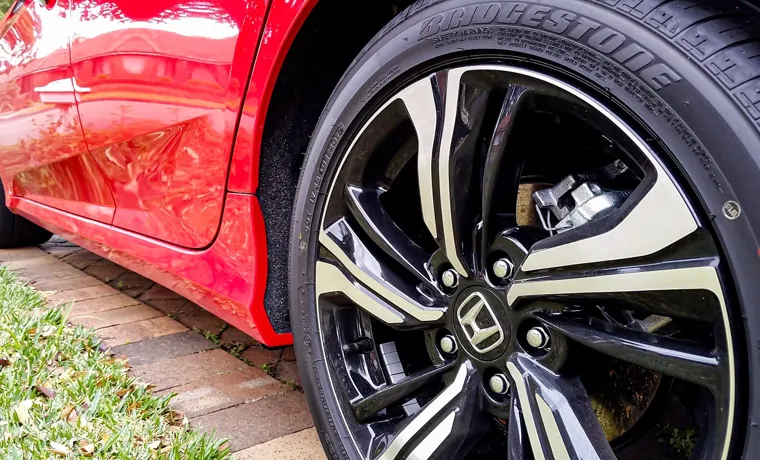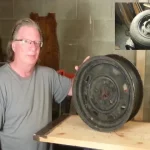Have you ever experienced turning on your car and seeing your tire pressure light on, even though you just got new tires on your Honda Civic? It can be frustrating to know that you’ve recently invested in brand new tires and yet, your car is signaling that something is wrong. There are several reasons why your tire pressure light could be on even after getting new tires. One common cause is that the tire pressure sensors were not properly reset after installing the new tires.
Another possibility is that the tires were not inflated to the correct pressure. It’s important to remember that your car’s tire pressure monitoring system is designed to alert you of any issues with your tires. While it can be easy to ignore the light, it’s best to address the problem as soon as possible to prevent any potential dangers on the road.
In this blog, we will discuss in detail why your tire pressure light might be on after getting new tires on your Honda Civic and what you can do to resolve the issue. So, fasten your seat belts and let’s dive in to learn more!
Table of Contents
Check Your Tire Pressure
Are you wondering why your tire pressure light is on after getting new tires for your Honda Civic? The answer could be as simple as not checking your tire pressure after getting new tires installed. New tires may not always be at the proper air pressure when they are put on your vehicle. This can result in the tire pressure monitoring system (TPMS) being activated, even though there may not be anything wrong with the tires themselves.
It is essential to check your tire pressure regularly, regardless of whether you have new tires or not, as low tire pressure can result in reduced fuel economy and even affect your vehicle’s handling. A quick and easy solution is to grab a tire pressure gauge and check the pressure on all four tires to ensure that they are inflated to the recommended PSI, which can often be found in your vehicle’s owner’s manual or on the inside of the driver’s side door. By checking your tire pressure regularly, you can avoid the hassle of a triggered TPMS and ensure your vehicle is performing at its best.
Check the Recommended Psi For Your Tires
Checking your tire pressure is an important part of vehicle maintenance that cannot be overlooked. One of the essential steps in this process is to check the recommended psi for your tires. This information can usually be found on the driver’s side door frame or in the owner’s manual.
The recommended psi is the ideal pressure for your tires, and it can vary depending on the type of vehicle you have and the type of tires you are using. It is important to note that over-inflating or under-inflating your tires can have negative impacts on your vehicle’s fuel efficiency, handling, and overall safety. So, it’s crucial to make sure your tires are inflated to the correct psi regularly.
You can use a tire gauge to check the pressure, which is inexpensive and easy to use. By keeping an eye on the recommended psi, you can extend the life of your tires and improve your driving experience.

Check the Pressure of All Tires
Checking the pressure of your tires is one of the most critical things you can do to ensure your safety and the longevity of your vehicle. Over time, tires lose pressure due to natural causes, and it’s essential to regularly check them to maintain optimal pressure. Low tire pressure can lead to poor fuel efficiency, reduced handling, and even a tire blowout.
It’s best to check your tire pressure at least once a month with a tire pressure gauge and to inflate them to the recommended pressure level listed in your vehicle’s manual or on the tire itself. Doing so will not only keep you safe on the road but can also save you money in the long run by extending the life of your tires. So, take a few minutes to check your tire pressure regularly, and you’ll be driving with more confidence and peace of mind on the road.
Adjust the Pressure As Needed
Tire pressure is an essential factor that we need to check frequently to ensure a smooth and safe ride. Irrespective of the weather, you should always know the right amount of air pressure, according to the vehicle’s specifications. Checking the tire pressure is often as simple as glancing at the label inside the driver-side door or in the vehicle manual.
To adjust the pressure, you should first remove the cap from the valve stem and attach the air pump hose to the stem. Inflate the tires until the pressure matches the number recommended by the manufacturer. Overinflating the tires can cause uneven wear and tear, while underinflation can make your ride bumpier and lead to poor fuel mileage.
A well-maintained tire helps to maximize fuel efficiency and save money in the long run. Therefore, it is worth investing a little effort to keep your tires correctly inflated.
Check the Sensors
If you’ve recently replaced your tires on your Honda Civic, you might be wondering why the tire pressure light is still on. One common reason for this is due to the sensors in your tires. New tires might not have the same sensors or may not be calibrated properly, which can cause the tire pressure light to stay on.
You might need to reset the sensors or recalibrate them to ensure proper tire pressure readings. Another reason could be that the mechanic who replaced your tires didn’t properly install the sensors or accidentally damaged them during the process. In either case, it’s important to have a professional mechanic check your sensors to ensure they’re working correctly, ultimately ensuring your safety on the road.
Overall, it’s important to pay attention to your tire pressure warning light as it can often indicate an issue with your tires that needs to be addressed promptly.
Understand How Tire Pressure Monitoring Systems Work
When it comes to a Tire Pressure Monitoring System, one of the most essential components is the sensors. These tiny devices are responsible for measuring the air pressure inside your tires and transmitting that information to your car’s computer system. The sensors typically use radio frequency technology to communicate with the car, which then displays the tire pressure on your dashboard.
It’s important to regularly check the sensors to ensure they are functioning correctly. Over time, the sensors can become damaged, especially if you accidentally hit a curb or pothole. If the sensors are not working properly, it can lead to inaccurate pressure readings, which can cause problems with handling, braking, and fuel efficiency.
So, if you notice your tire pressure monitoring system is not functioning as it should, it’s best to get the sensors checked out by a professional. Maintaining your sensors will help ensure your car is running at its best, with proper tire pressure for optimal performance and safety.
Check That the Sensors Are Working Properly
When it comes to ensuring optimal functioning of your smart home system, it’s crucial to check that all the sensors are working properly. These sensors are responsible for detecting changes in temperature, motion, and other environmental factors, which trigger various automated actions throughout your home. To check whether your sensors are functioning correctly, start by inspecting them visually for any signs of damage or wear.
Next, test each sensor by triggering it and checking if the system responds appropriately. This could involve walking in front of a motion sensor or manipulating the temperature to see if the thermostat adjusts accordingly. If you notice any issues with your sensors, it’s important to address them promptly to prevent further damage or system malfunctions.
By taking the time to ensure that all the sensors within your smart home system are functioning correctly, you can enjoy the benefits of a streamlined and efficient automated home.
Verify the Installation of the New Tires
If you’re wondering why your tire pressure light is still on after getting new tires on your Honda Civic, it’s essential to verify the installation. While it’s normal for the light to turn on initially after installing new tires, it shouldn’t remain on for long periods. Begin by checking the tire pressure in each tire, including the spare.
Use a tire pressure gauge to measure air pressure and ensure that it corresponds to the manufacturer’s specifications. If the pressures are within the accepted range, then it’s likely that the installation went smoothly. However, if there are any issues, be sure to consult a professional mechanic.
Additionally, it’s essential to check for any leaks by using soapy water and checking for bubbling around the valve stem, bead area, or anywhere near the tire. Overall, it’s always good practice to double-check the installation after getting new tires to avoid any long-term issues.
Check That the Tires Were Installed Properly
When getting new tires installed, it’s important to verify that the job was done properly. Improperly installed tires can lead to all sorts of problems, from decreased fuel efficiency to increased safety hazards. Before you drive off, take a few minutes to visually inspect your tires and make sure they’re seated properly on the rims and that the lug nuts are tightened to the correct torque specifications.
Additionally, make sure the tires are rotated in the correct pattern (if applicable) and that the valve stems are properly seated. Remember, your tires are the only thing connecting your car to the road, so don’t take any chances when it comes to their installation. A little bit of vigilance now can save you a big headache down the road!
Check for Any Damage to the Tires or Wheels
When you install new tires, it’s important to give them a thorough inspection to ensure they’re installed correctly and free from any damage that could cause issues down the road. Start by verifying that the size and type of tires match what you requested and what’s recommended for your vehicle. Next, check to make sure the tires are properly balanced and aligned, which will help prevent uneven wear and improve handling.
Inspect the tread depth to ensure it’s within safe limits, and be on the lookout for any cuts, punctures, or bulges that could indicate damage to the tires. It’s also important to inspect the wheels for any signs of damage, such as bends or cracks, which could compromise safety. By taking the time to carefully inspect your new tires and wheels, you’ll be helping to ensure they function optimally and last as long as possible.
Conclusion
Well, my dear Honda Civic owner, it seems that your tire pressure light is on because your new tires are just too darn perfect. After all, perfection can be a tough act to follow. Your car’s tire pressure monitoring system is simply adjusting to the fresh, flawless rubber on your wheels.
So, consider yourself lucky to have such impeccable tires and let your car’s system catch up to their greatness. Happy driving!”
FAQs
1. Why did my tire pressure light come on after getting new tires on my Honda Civic?
It’s common for a tire pressure light to come on after getting new tires because the system needs to be reset. Take your vehicle to a nearby service center and they can reset the tire pressure monitoring system for you.
2. How do I reset the tire pressure monitoring system on my Honda Civic?
To reset the tire pressure monitoring system on a Honda Civic, simply press the “Set” button until the tire pressure light starts flashing. Then, hold down the “Set” button and wait for the light to turn off. This indicates that the system has been reset.
3. Can low tire pressure cause damage to my new tires on my Honda Civic?
Yes, low tire pressure can cause damage to your new tires on your Honda Civic. Make sure to keep your tires properly inflated to avoid wear and tear, as well as to ensure safety while driving.
4. How often should I check the tire pressure on my Honda Civic?
It’s recommended to check the tire pressure on your Honda Civic at least once a month, as well as before embarking on a long trip. This will ensure that your tires are properly inflated and will help extend their lifespan.
5. Can I rely solely on my Honda Civic’s tire pressure monitoring system to keep my tires inflated?
While the tire pressure monitoring system on your Honda Civic is helpful, it’s still important to manually check your tire pressure regularly. The system may not always detect a gradual decrease in pressure, which can lead to damage or safety concerns.
6. What should I do if my Honda Civic’s tire pressure light keeps coming on even after adding air to my tires?
If your Honda Civic’s tire pressure light continues to come on even after adding air to your tires, there may be a leak or other issue with the tire. It’s best to take your vehicle to a professional to get it checked out.
7. Do different driving conditions affect my Honda Civic’s tire pressure?
Yes, different driving conditions can affect your Honda Civic’s tire pressure. For example, colder temperatures can cause lower tire pressure. Make sure to check your tire pressure more often during extreme weather conditions.



